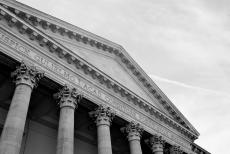1. Aula

UGentPassage starts at the university's Aula, its main auditorium and lecture theatre. A ideal place to commence the tour, as it symbolizes the start of the relationship between city and university. The Aula is a glorious gift of welcome from the city to the university. To this day, it is the ceremonial heart of Ghent University.
The intention of the architect, Louis Roelandt, to mimic the columns and pediment of a Greek temple is obvious. The Aula is a "temple of science", where reason is celebrated. Roelandt uses many classical elements both outdoors and indoors, adding to the monumental nature of the building. Art experts are critical though: they believe that the auditorium is a stylistic cacophony. But the university and the city are not bothered: 19th-century travel guides quickly rate the Aula as a three star site.
After the joyous inauguration in 1826, the university adorns its lavish palace with symbols and rituals. Professors, students, administrators and politicians use the symbolic value of the Aula to make statements about the state of science, education, the university, the people and the country. The battles fought there over time, verbally, musically or with fists, are numerous. All of this turns the Aula into a place that oozes memory and history.
The town and its citizens, generous donors as they are, always find an open house in the 'Palace of the University’. For instance, at the opening of the academic year, not only does the Rector give a speech here, but so does the Mayor. Until the First World War, the city awards prizes to the best grammar school pupils during the opening ceremony. Associations from Ghent, such as the famous Floralies, find in its halls the perfect location for their exhibitions. Even the Belfry Dragon found shelter in the Aula in 1912 when the tower of the Belfry was renovated. In 2000 the artist Jan Fabre decorated the columns with ham: an image that the citizens of Ghent will remember for a long time.